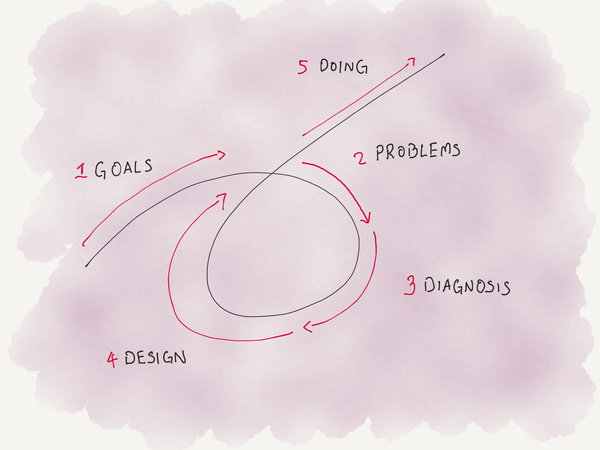This is part 4 of the Principles Sequence, a series on the Ray Dalio book. Read the overall book summary here.
I’m currently a ‘solopreneur’ — one of those people who saved up money for a 2 year shot at building a self-sustaining business. If I fail, I go back to getting a job. If I succeed, I have what’s called ‘optionality’: an income stream divorced from my efforts. I could go away for a month and still earn money. Or I could start working for someone again with an income stream on the side. Optionality means having the option to choose, and I’m struggling for 2 years to earn that option.
That’s the dream, at least.
The biggest challenge to my current goals is time. I have 2 years, and a seemingly-unlimited array of options and opportunities ahead of me. That’s usually how it is. If you’ve ever quit your job to chase this path I’m on, know this: you’re going to get a hell lot of opportunities thrown your way.
Ex-bosses, friends with ideas, acquaintances in other industries with business problems you know you can solve. Which opportunities do you go for? Which one lets you achieve your goal? You’ve got 24 months to burn; it’s not clear what’s the best use of those months.
Actually, I lied. Rereading Principles has been useful precisely because of this optimisation problem. My biggest enemy isn’t really time. My biggest enemy is me.
Dalio’s 5 Step Process
This post summarises Dalio’s “5 Step Process for Getting What You Want Out of Life”, the second chapter in the second part of the book (“Life Principles”).
The 5 steps read like trite, common-sensical garbage:
- Have clear goals.
- Identify and don’t tolerate problems that stand in the way of your achieving your goals.
- Accurately diagnose the problems to get at their root causes.
- Design plans that will get you around them.
- Do what’s necessary to push these designs through to results.
I know what you’re thinking: “Duhhhhhhhhh”. These are obvious statements. But the proof of the pudding is in the eating, and the efficacy of these steps lie in how well you do them. Consider just two questions: a) how often do you do these steps systematically, and b) do you compensate for the steps you are bad at?
I bet most of us do some of these steps intuitively. Dalio isn’t interested in intuition. Human intuition is inconsistent and often wrong. You can only debug a process if it’s systematic and rationally considered; most of us don’t perform these steps in nearly as rationally, dispassionately, or as efficiently as Dalio would have us do them — it’s too difficult. The draw of Netflix is more powerful than the draw of painful introspection. We waffle on our goals, lie to ourselves so we don’t have to discover potential problems, aren’t equipped to accurately diagnose our problems, and then we design ineffective plans and half-ass them. (More about all these failure modes in a moment).
The other aspect Dalio urges us to consider is that we are all bad at one or more of these steps. No human could possibly be good at all 5; they demand a completely disparate set of skills and mental frameworks. You will find that you are good with several of these steps, and bad at others. Part of using the 5 step process is recognising which steps you are bad at and compensating for them.
This post is going to be slightly different from the rest. I'd like you to follow along with some goals of your own. Download the following worksheet and fill it in as you read; I'll use myself as an example for you to follow.
Download the worksheet here: dalio_5_step_process_worksheet.pdf
What I’m bad at
Before I begin with the 5 step process, I should admit to myself which of the 5 steps I’m bad at. You should do the same. Here goes:
- I can set clear goals, and I have. 7 years of building organisations does wonders for clear, measurable goal-setting.
- I used to be bad at identifying problems. I lied to myself a lot. As I mentioned in an earlier post, I sucked so bad at this I failed 2 university classes, broke up with my first girlfriend, and lost my first startup because I refused to admit to myself that I had problems. I’m slightly better at this now.
- I can accurately diagnose root causes if I bring myself to recognise that there’s a problem. If I’m lying to myself, then, well.
- I’m pretty good at designing solutions to problems I’ve diagnosed, but:
- I have problems with execution. Particularly now, given that I’m on solopreneur mode and totally on my own, I’ve found myself regularly doubting my decisions. It’s started to become a hindrance when I’m executing. I’ve also found that I have a sine-wave energy curve. Some weeks I get a lot done, sometimes I don’t feel like doing anything. Meh.
So that’s 2 bad out of 5. If you’re reading this, your eyeballs probably just skimmed over the list above. You probably thought it was easy for me to write that. It wasn’t.
(It’s funny how you can edit your writing to sound breezy and light, when writing the words itself felt like wringing juice from a rock.)
I mention this because I’d like to give you a demonstration of the kind of difficulties you’ll face while doing this exercise. I think anything that requires you to introspect effectively will cause you pain. Step 5 (Execution) was particular difficult to diagnose for me, because I pride myself on my ability to execute well. It was quite … jarring to admit that I needed some adjustments now that I’m on my own. My advice: just push through it. You know it’s for your own good.
Step 1: Have Clear Goals
I'm going to give a quick run-through on Dalio's advice, and then apply it to my situation as an example:
- Prioritise: you can’t have everything. That means thinking about what you’re denying yourself when you choose a specific goal.
- Don’t confuse goals with desires. A desire is something like “Be happy”. A goal is “Get promoted to Level 4 by the middle of next year”. Desires can often get in the way of goals; be sure not to conflate the two.
- Decide what you really want in life by reconciling your goals and your desires. This exercise is highly personal — your goals should reflect your true desires. So, “become CEO” might not be compatible with the desire to ”be happy”. Related: don't mistake the trappings of success for success itself.
- Never rule out a goal because you think it's unattainable. Once you pursue a goal you will learn new things, which increases what's attainable. So don't base your goals on your current skill levels. Great expectations create great capabilities.
- Knowing how to deal with your setbacks is as important as making progress towards your goals. You're going to get kicked in life. In bad times, you might need to change your goals to preserve what you have, in order to take a second shot later. Just make the best possible choices you have available to you at the time, knowing that over time, you'll be rewarded if you do.
My goal is to build a sustainable business that provides for me and mine. The short term goal is to build a business with $500 in recurring revenue by December 31st 2018, the end of this year, OR sell a product that makes $3000 by the same date, so long as that product creates an audience.
Step 2: Identify and don't tolerate problems.
Identifying problems is something that I'm weak at. Mostly because I have a tendency to lie to myself when I'm facing a problem.
I was given a nasty reminder of this weakness when I joined Entrepreneur First's 3rd Singapore batch (EFSG3) earlier this year. EF, like most other startup incubator programs, possess a revolving host of startup advisors to help you on your journey. I had difficulty listening to some of them, when I should have been more open-minded and humble.
- View painful problems as potential improvements that are screaming at you. This is a mind hack. If you feel pain, that's probably a good sign that you have a problem you can diagnose and work on.
- Don't avoid confronting problems because they are rooted in harsh realities that are unpleasant to look at. Maybe this is a function of my abilities. In EF, advisors push you to validate early and often. This is standard, boring, startup advice. What I didn't get was that there is an internal component to it: you have to be mentally prepared to have your ideas crushed. The good news is that I'm now on my own, with a low burn, without the artificial time constraints of a VC-funded, return-driven program. I can take the time I need to reconfigure my internal state.
- Be specific in identifying your problems. Most people aren't willing to do this because they think having weaknesses is the same as surrendering to them. It isn't. It's the first step to overcoming them. This implies that you need a precise, specific description of your problem, because different problems require drastically different solutions.
- Don't mistake a cause of the problem with the real problem — “I can't get enough sleep” vs “I play too many computer games at night”.
- Distinguish big problems from small ones. Self evident; just be careful that the small problems aren't symptoms of bigger ones.
- Once you identify a problem, don't tolerate it — tolerating a problem is the same as not identifying it in the first place. Down this path lies hopelessness.
My biggest problem is distribution. I can build any software product I want, given the number of years I've spent learning to build products. I can solve a large set of business problems. But if I can't get people to hear about it, I'm screwed.
I have built an audience before. Back when I was a teenager, I built Novelr.com, which was a site for web fiction publishing. But the skills I used to build that audience may be irrelevant today — in the 11 years since I did Novelr, online reading habits have changed drastically. People don't read blogs as much. The majority of content consumption happens on social media. I haven't kept up to date with social media marketing; I don't even have a Facebook account. This is a problem.
Step 3: Diagnose problems to get at their root causes
Once you've identified a problem, drill down to get at the root causes. I'm actually pretty good at this. Let's dive in:
- Don't jump to solutions first. Diagnosing problems properly take between 15 minutes and an hour. You want an angle where you can effectively tackle the problem. Too many people jump to solutions immediately after they identify a problem. Resist this urge, as you may be solving the wrong thing.
- Distinguish proximate causes from root causes. Root causes can be painful to admit. Dalio argues that proximate causes are typically the actions (or lack of actions) that lead to problems. They are typically described using verbs (“I missed the train because I didn't check the train schedule”). Root causes run much deeper and are typically described using adjectives (“I didn't check the train schedule because I am forgetful”). You must solve root causes, not proximate ones.
- Recognise that knowing what someone (including you) is like will tell you what you can expect from them. Remember the ‘pain’ bit I mentioned above? Yeah. This is why. Sometimes the root causes for an issue is a weakness with the person involved. You may be the reason you've lost 5 employees over the past year. Or your subordinate is responsible for losing the last 3 deals, and needs to be fired. People-related root causes are always more painful to deal with. Dalio argues:
More than anything else, what differentiates people who live up to their potential from those who don't is their willingness to look at themselves and others objectively and understand the root causes standing in their way.
So let's diagnose my problem.
My problem with getting an audience is that I lack marketing skills suited for the current reading climate. Facebook has become dominant. Twitter — the only social network I'm on — is on the decline. I don't really have marketing skills, and I need to gain them.
But, wait, I didn't feel any pain admitting that. This is a proximate cause of my problem, not a root cause. If the problem really was my lack of marketing skills, I would have put together a plan for learning them by now, and executed it. But I haven’t, and I’ve not.
The root cause is that I don’t feel comfortable doing marketing! I would have to put myself out there and expose my work to others. What if I fail? What if nobody likes what I’ve done? What if my personality — so tied to the brand of content marketing I’m doing, is found wanting? This psychic barrier stands in the way of me taking action about my lack of content marketing experience.
Notice what just happened. I tried looking for the root cause of my problem, and my brain started offering up plausible-sounding, comfortable answers. Answers that it knows I can deal with without much pain. If the problem really was ‘lack of content marketing skills’, then my solution would be ‘get those skills’; if it was ‘fear of becoming a marketer’ then the solution would be the rather more painful ‘become someone who is not scared of marketing’.
Step 4: Design a Plan
This is the fun part. Yay, plans.
- Think about your problem as a set of outcomes produced by a machine. Dalio likes machines. Machines are understandable and controllable.
- Remember that there are typically many paths to achieving your goals. You only need to find one that works.
- Think of your plan as being like a movie script in that you visualise who will do what through time. I’m not sure why Dalio recommends creating a narrative, but he does. Visualise what needs to happen and in what order, and sketch it out broadly. Then, refine it by turning the narrative into specific tasks and estimated time lines. Follow down the natural process as you drill deep into the details.
- Write down the plan for everyone to see and to measure your progress against. This includes who needs to do what tasks and when. Keep the tasks, the narrative and the goals separate. The tasks connect the narrative to the goals.

So what’s my plan? I’ll still have to get those marketing skills. But I’ll need to deal with my internal mentality-related problems first.
First, context. I plan to build audiences for both Commoncog and an as-yet-unnamed management course. The management course would be sold as an information product — it happens to be the same management course I taught when I was replacing myself at my last company.
My thinking is that building an audience before building an app reduces my risk. I’m not sure if this is the best way to think about this, but it’s certainly one path that works.
So here’s the plan: I’m going to be using an 8-week “monk mode” work cycle. By the end of Week 7, I must have the management course ready for launch. By the end of Week 2, I must have 90% of the course materials written out and ready for testing (given that most of the course already exists, this isn’t that difficult). That leaves Weeks 3—6 for testing, tweaking and marketing.
The real challenge is the marketing bit, not the testing bit. My current plan is to try a number of techniques, and to keep evaluating between Weeks 3—6:
- Content marketing (low yield): write 4 blog posts a week. (Yes, that’s 4 blog posts a week on top of the 2 I write weekly here at Commonplace. This isn’t actually that difficult for me; I enjoy writing very much).
- Republish all content on Medium.
- Start a management twitter bot.
- Get testimonials from previous colleagues whom I’ve trained as managers
- Get a one-pager package on Hacker News.
- Test keywords for SEO, using Google Adwords
I have no clue if these ideas are any good; I don’t have the skills, after all. So a large component of my plan would be reading up on content marketing using Commmoncog throughout the entire 8 week plan. Needless to say, I need to self-evaluate and adjust at the end of every week.
Step 5: Push Through To Completion
The last step, of course, is execution. Dalio’s guidelines here are straightforward:
- Great planners who don’t execute their plans go nowhere. No shit.
- Good work habits are vastly underrated. People who execute well are organised: they have todo-lists that are prioritised and they make sure each item is done in order.
- Establish clear metrics to make certain that you are following your plan. You need to make sure that you’re on track to hit your intended targets. Have someone other than yourself to check up on you. If you discover new problems, repeat this process and adjust accordingly.
My progress is alright. I’m currently at Week 2 of my 8 Week Plan. The course is 70% done at this point — I just have a small collection of worksheet materials to be designed, but I’m likely to finish it by the middle of Week 3 (which starts next Monday). As of today, I haven’t started marketing, due to my being scared of marketing.
That has to change. And I plan to repeat the 5 Step Process for that.
Conclusion
This has been a long post, because it’s meant to be a tutorial for applying Dalio’s 5 Steps to a real problem. I’m hoping that you would try this out on something you care about. Download the worksheet here and try it out, then tell me what you think.
Next: part 5 — On Lying To Yourself
This is part 4 of the Principles Sequence. Subscribe here, or follow the blog on RSS/Twitter.
Originally published , last updated .





